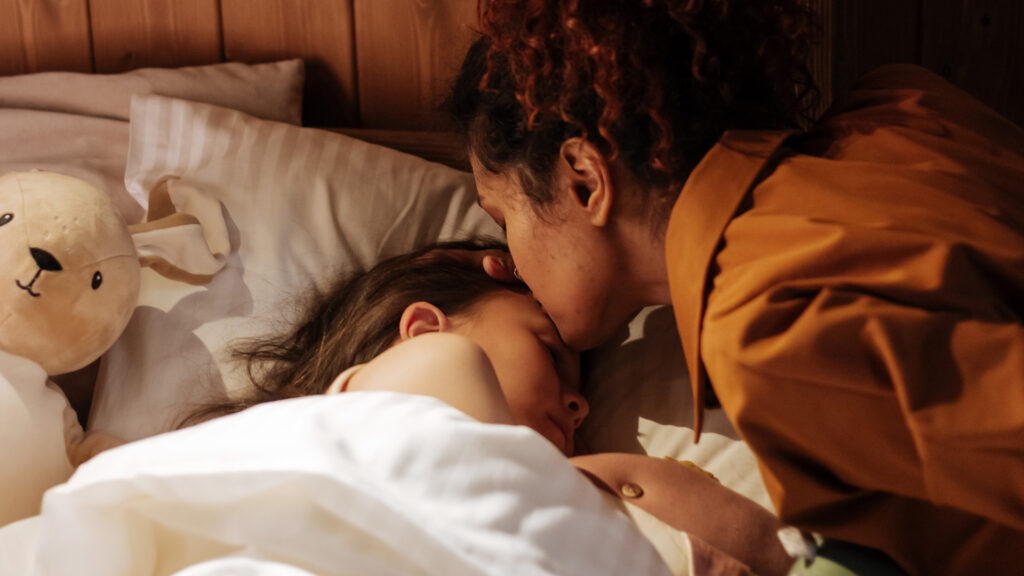
Once upon a time, there was a tired parent who wanted their kids to go to sleep. The problem was instead of a bedtime book, the kids wanted a made-up bedtime story and, lacking imagination and energy, the tired parent didn’t know where to begin.
Making up a story can be challenging for so many reasons. By bedtime you might be out of ideas, stories can lack structure or character development, and the plot holes can cause more questions than relaxation.
Bedtime stories of any kind can be hugely beneficial for children, helping develop early language skills, boosting vocabulary and improving literacy rates. “They promote imaginative thinking and creativity, they teach children positive values, they give children characters or situations they can relate to and learn from, and they bring happiness and laughter in a positive way,” explained Reena B. Patel, parenting expert, psychologist and children’s book author.
Next time your children request made up bedtime stories, or you’d like to mix up their evening routine with some creative storytelling, try some of these ideas to become a bedtime hero and make up wonderful stories for kids.
Involve Kids in the Story
If you are struggling to get your stories going, don’t be afraid to get your children to share the load. Zoe Ayre, author of children’s book I Will Always Help You Sleep, suggests making the most of their vivid imaginations and asking them what kind of story they would like. “If they struggle you could give them prompts to help them choose the direction they want the story to take e.g. would you like the story to be about magical things or set in the real world?” she says.
Allowing children to participate in stories gives you a break and helps encourage their creativity, says Patel, who has an idea for reducing the pressure on you to tell the whole story. “Taking turns developing the plot line is a great way to encourage participation. Simply go back and forth with your child sentence by sentence, until the storyline naturally comes to a conclusion, or until one of you says the end.”
Use Traditional Story Structures
Build stories with a familiar narrative structure of beginning, middle, climax, and end recommends teacher and founder of Phonics with Robot Reg, Alex Burnside. “Think of it like a mountain where the beginning and middle are climbing up the mountain, the climax is at the top of the mountain, and the ending is you walking down the mountain,” he says.
There are classic storytelling formulas to help. “If you’re struggling with this, I’d look into ‘The Hero’s Journey’, which is a common template that’s been used to tell stories for millennia,” suggests Oliver Sykes, author of children’s books Alfie’s First Flight and Fishing for Rainbows. “A hero goes on an adventure, leaving the familiar world behind, learns a lesson by navigating the unfamiliar world, wins a victory with that newfound knowledge, and then returns home transformed.” While these templates can be useful, don’t worry too much about following the rules.
Borrow From Other Stories
If you don’t want to make up a totally new story, use an existing one and change some elements like the setting or characters. “Change the end in a way to add a twist to the tale and something that is not expected,” suggests Burnside. Take the pressure off and remember your children likely won’t know all the stories you do, or know you are referencing other material.
Don’t worry about creating totally brand-new characters either, borrowing ones from movies, toys and real life is a good way to make your stories accessible. “Children love being able to see themselves represented within stories – using their names or their favorite toys can be a brilliant way to help them connect to the story,” says Ayre.
Keep Stories Simple for Younger Kids
Good news for tired parents, bedtime stories don’t need to be complicated. “Remember when you tell a story there are no pictures so the child will need to construct and imagine this in their head, having anything too complicated will make this tricky,” says Burnside.
“Stick to familiar settings, familiar structures, and some familiar characters to start with and as your child becomes more familiar with listening to stories then you can make it a bit more elaborate.”
Reminder: Bedtime Stories Don’t Need a Moral
Bedtime stories don’t have to be serious morality tales for your kids to learn from; they can be a place for fun and connection. “While most of my stories include a moral or piece of advice, I certainly don’t think it’s important that every story does,” says Sykes. “Some stories are just nonsensical bits of fun – and that’s absolutely fine.”
Stories at bedtime don’t need to be calm either. “Sometimes, getting their sillies out can actually improve sleep and can get rid of some of that pent up energy before bed in a fun way,” says Ayres. “We can sometimes get bogged down trying to find the moral or a positive message – but stories can be just as brilliant – and sometimes even better – if they just make us laugh.” You could tap into your child’s sense of humor, interests and hobbies to make it even more fun and personal.
Don’t Overthink the Ending
Finishing a story can be tricky but if you stick to a familiar ending — like good overcoming evil or the main character saving the day — it can be easier and even help you kids fall asleep. A clear ending “signals to your little one when storytime is over and it’s time for sleep,” explains Ayres.
Remember you aren’t aiming for a Pulitzer; your stories don’t need to be perfectly constructed, full of themes and end with the best conclusion. “Stories aren’t about having a perfect ending all the time, it’s about the fun you have along the way,” Sykes says.
You could experiment with adding a sleepy epilogue to help your children drift off. Perhaps the characters head home after the action, can’t stop yawning, snuggle up in bed and fall asleep. Hopefully your real-life children won’t be too far behind on their journey to sleep, which really is the perfect ending.
Sources
Patel, Reena. Author interview. May 2024.
Ayre, Zoe. Author interview. May 2024.
Burnside, Alex. Author interview. May 2024.
Sykes, Oliver. Author interview. May 2024.




























